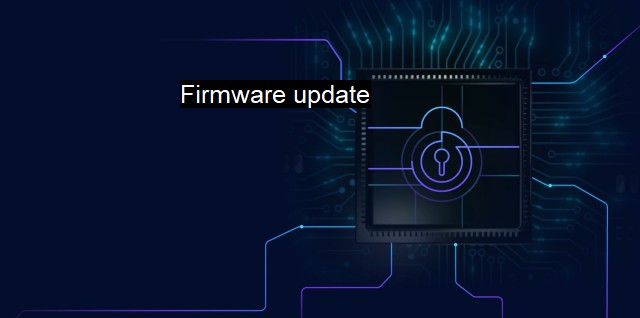What is Firmware update?
The Importance of Firmware Updates in Ensuring Cybersecurity and Device Performance: Exploring the role of firmware updates in enhancing device functionality, security, and performance.
The term "firmware update" plays a formidable role. Firmware is essentially the staff underneath a device's hood that pilot all its functions smoothly. Firmware resides in non-volatile memory devices such as ROM, EPROM, or flash memory inside electronic gadgets, and it is designed to be perpetually stored even after the device is turned off. Updates to this firmware are hence vital for the seamless operation of the device as well as its defenses against potential cyber threats.In delineation, a firmware update is a legitimate enhancement or makeshift released by manufacturers to resolve possible hardware concerns on the device. It can be likened to software updates on computers, which offer patches for bugs, design improvements, new features, and as avidly applicable solutions for security vulnerabilities.
A reputed firmware update can offer a broader countenance against cyber threats, granting the device bolstered security specifications and refining the existing ones. This can potentially result in fewer fissures for malicious activities to seep into the system. As it accredited manufacturers, updates typically undergo complicated testing processes before they are issued to ensure enhanced performance and, importantly, no openings for cyber incursion.
In this digital era, hackers are continually scouring for means to infiltrate devices, compromise data, and initiate malicious invasions. Understanding that firmware can customarily hold the keys to running typical hardware in devices, it becomes apparent why it is often the bullseye for such cyber-attacks. Attackers often dissent to use worm or virus to attack the uppermost application layers. Firmware, denuding in the deeper system layer, becomes the object of attack which can result in dire consequences.
Manufacturers are irrevocably announcing firmware updates to fix identified vulnerabilities and ward against possible system incursions. Firmware updates target a bottleneck, resolving hardware-related issues, adjusting features, offering protective shields against theft, and tamping additional protective layers over persistent threat landscapes to prevent cyber-attacks.
Notably, the aftermarket placement of antivirus software can add to the overall cybersecurity in terms of protective strides against viruses and malware attacks. Coupled with firmware updates, they together present formidable resistance for cyber-attackers, tightening the security bolts of electronic devices and heavily fortifying them.
Consider, for instance, the antivirus endeavors privileged defenses against malicious invasions like viruses, ensuring the security of the operating system and valuable user data. The antivirus software usually informs of the face of possible threats, and as it regularly needs database updates to stay functional against emerging vulnerabilities corresponding to new virus types.
Similarly, these updates cater to known vulnerabilities in firmware that, in turn, usher increased underway of operation, providing, and maintaining advanced defenses. Merely put, while an antivirus restricts or prevents attacks, firmware updates banish 'weak links' that could be potentially mangled by an attacker.
The extraordinary circle initiating with manufacturers releasing a firmware update, followed by organizations executing the update expeditiously befitting their devices, and finally the failure of an attack on updated firmware - exemplifies the weightiness of firmware updates.
Updating firmware might uproar the fear of possibly stuttering the system intermittently, but that's far outweighed by the paramountcy of ensuring a fortified stance against cyber threats, ultimately maintaining the integrity of the device in a cyberspace environment growing progressively volatile.
a cooperative engagement of firmware update, antivirus software, and the user's alertness impersonate the trio safeguarding the cybersecurity paradigms. The firmware update is, therefore, not just an offstage crew member but figures significantly in the typical cybersecurity narrative. Ingraining it among the regular high-priority tasks, with understanding and prudence, can usher in a dramatic difference to a device's longevity and security, making firmware updates an ideal 'cybersecurity investment.'

Firmware update FAQs
Why is it important to perform firmware updates for security purposes?
Firmware updates often contain security patches and bug fixes that address vulnerabilities in the system. By updating the firmware, you are staying ahead of potential cyber threats and lowering the risk of a breach.How can I check if my device needs a firmware update?
Typically, the manufacturer's website will have information on available firmware updates for specific devices. You can also check the system settings on your device to see if there are any available updates.Is it safe to perform a firmware update on my own?
It is generally safe to perform a firmware update on your own, but it is important to follow the manufacturer's instructions carefully. Failing to do so could lead to system errors or even render the device unusable.What should I do if a firmware update fails?
If a firmware update fails, do not panic. Follow the manufacturer's instructions on how to troubleshoot the issue or contact their technical support for assistance. It is important not to try and force a firmware update as this could potentially cause further issues.| | A | | | B | | | C | | | D | | | E | | | F | | | G | | | H | | | I | | | J | | | K | | | L | | | M | |
| | N | | | O | | | P | | | Q | | | R | | | S | | | T | | | U | | | V | | | W | | | X | | | Y | | | Z | |
| | 1 | | | 2 | | | 3 | | | 4 | | | 7 | | | 8 | | |||||||